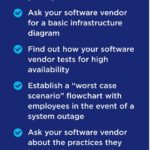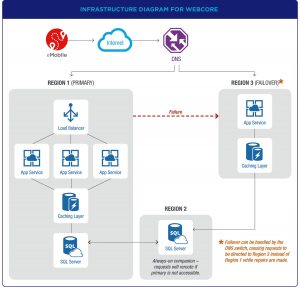Learning how to depend on technology.
By Jed Dawson
It is hard to deny that the automation provided by technology has made our lives easier in more ways than one. Cutting edge software has presented efficiency and flexibility that was not possible up until a few years ago. Billing processes that used to take hours can now be completed in a matter of minutes. Automatic recurring payments ensure a reliable and steady stream of revenue early in the month. Service performance information is collected by driver’s tablets in the field and synced into your billing and routing systems automatically. Generating additional revenue for extra services that are verified by location and image are simple processes. New services are instantly added to the correct routes and equipment is seamlessly scheduled for delivery.
Hope for the Best, Plan for the Worst
The benefits of technology are magical when everything runs smoothly, but are you prepared for that inevitable day when things just do not work? Whether it is a software bug, hardware failure, malicious act or a natural disaster, eventually your organization will be impacted in some way by a software failure. It may be a few minutes, it may be a few hours—and hopefully not a few days. It is vital that you familiarize yourself with processes and procedures put in place to guarantee your company’s survival when the system goes down.
As someone who has a foot planted in both waste hauling and software development, I have a unique perspective on what can go wrong and how it will impact hauling operations. What follows are tips and best practices that you can put in place to ensure that you are not crippled during the inevitable service interruption.
The Number One Rule in Software Availability is Redundancy
Ensure that your software vendor is providing you with redundant systems, meaning you have more than one of everything: servers, databases, regions, you name it. Ideally, you will have a vendor managing all of the technology for you. It is a specialized service (not unlike waste hauling) that a professional organization will perform with more skill and expertise.
If your software vendor has not provided you with a basic infrastructure diagram, contact them and ask for it. It is possible that they have multiple regional availability zones, but your company has not signed up for that level of redundancy. Next, find out how they test for high availability. They should be able to turn off servers and disconnection datacenters without any noticeable impact. Testing redundancy is difficult and nerve-wracking, but frequently and consistently testing your system will instill confidence in your software being highly available. Find out what your software vendor does to ensure their systems are reliable and ready for failures.
Establish a Game Plan within Your Organization
 Once you can rely on your software vendor’s infrastructure covering you with high availability, it is time to plan for the 0.01 percent chance their systems and procedures do not work as expected. Communicate across all levels of your organization about the harsh reality of operating without technology when you least expect it. Set operational priorities ahead of time. Establish a framework to guide choices of when to halt and when to continue without technology. Do you want drivers to go off of memory and get the job done? Should customer service take detailed notes for each request so it can be handled when the systems become available? Having these broad scenarios in place will help to lessen the blow during an outage.
Once you can rely on your software vendor’s infrastructure covering you with high availability, it is time to plan for the 0.01 percent chance their systems and procedures do not work as expected. Communicate across all levels of your organization about the harsh reality of operating without technology when you least expect it. Set operational priorities ahead of time. Establish a framework to guide choices of when to halt and when to continue without technology. Do you want drivers to go off of memory and get the job done? Should customer service take detailed notes for each request so it can be handled when the systems become available? Having these broad scenarios in place will help to lessen the blow during an outage.
Put Cyber Threats on Your Radar
In recent years there have been some high-profile data thefts that everyone should be taking seriously. Have your software vendor provide you with information on how they are protecting their network from malicious intrusion. Are they applying all vendor-supplied security patches as they become available? Do they have denied-by-default firewall rules? Is all of the data that passes between your location and theirs encrypted? How about driver tablets? Are they using a PCI DSS-compliant tokenization and sanitizing all log files to ensure credit card numbers are never stored in plain text? What are they doing to ensure this is all functioning correctly? These are some big questions, and without asking them you cannot be certain your customer’s sensitive data is properly secured. Even the best software can have security weaknesses so it is also a good idea to talk about these concerns with your insurance provider. Ask them about liability coverage in the event of a cyber threat so that you are able to handle the possible financial burden that comes along with it.
Help Them Help You
At the end of the day the risk of technology is still outweighed by its benefits. The hauling operation I managed previously saw tremendous success on the shoulders of software vendors by streamlining every aspect of the organization. Whenever the inevitable outage occurs, I know the people that build the technology are working hard to restore order as quickly as possible. The service they provide to you is dependent on their software functioning properly. By being prepared for the outage you will experience a lighter impact and help the recovery process gain traction more quickly.
Jed Dawson is the lead developer of the Cloud and Mobile Software team at Core Computing Solutions, Inc. (Jacksonville, FL). Prior to software engineering, he was the Operations Manager at Paso Robles Waste & Recycle, Inc. and spent years embedded in all aspects of the hauling operation. He can be reached at [email protected].

